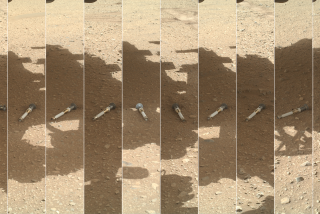JPL Unveils Its Red Planet Rover
Science teams at the Jet Propulsion Laboratory in Pasadena on Wednesday presented their latest progeny, a feisty 1-foot-tall Mars rover, to a group of white-suited reporters, photographers and NASA officials in a JPL “clean room.” The latest addition to JPL’s family of planetary voyagers will soon undergo final testing in preparation for its trip to Mars later this year.
The six-wheeled, 25-pound rover will be the first of a number of Mars missions scheduled over the next decade. It comes equipped with stereo cameras to see its way around, a peashooter-type gadget that spits out atomic nuclei to determine the chemical nature of rocks, laser navigation guides and enough hard-wired intelligence to steer itself around obstacles.
The rover and the rest of the Mars Pathfinder assembly is engineered like a series of Russian dolls. It will be launched aboard a Delta II rocket, then separate and travel to Mars attached to a round “cruise stage” equipped with rockets and navigation aides.
As the craft hits the Martian atmosphere, the cruise stage drops away. A cone-shaped heat shield encases the craft as it parachutes to a point about 10 stories above the Martian surface. It then will drop the rover, named Sojourner, encased in a tulip-shaped lander whose petals unfold once it hits the surface.
Giant air bags will automatically inflate into a 15-foot-diameter sphere to cushion its fall--and JPL scientists fully expect the ball to bounce like a Super Ball off Mar’s dusty surface before coming to a stop.
Part of the excitement surrounding Pathfinder stems from the fact that JPL is finally on the road to Mars again after the billion-dollar Mars Observer--NASA’s last missionary to the Red Planet--went astray two years ago. It is also the beginning of a major NASA push to Mars. Later this year, the Mars Global Surveyor will also be launched toward Mars--followed by more missions every 26 months until 2005.
Sojourner is in many ways a first-of-a-kind technology. One technical trick allows the robot to travel to Mars compressed. “It’s kneeling now,” said Mars program manager Donna Shirley. “When it gets to Mars, it will stand up to its full height.”
Then two 6-foot metal runways unroll to make a path onto the dusty Martian surface.
The rover’s stereo cameras give 3-D control to engineers wearing stereo goggles on Earth. Twice a day, JPL will send instructions at light speed (a 10-minute trip) telling the rover which nooks and crannies to explore.
Once it has arrived at a promising spot, the tiny explorer reaches out a super-flexible mechanical arm to place its chemical analyzer on rocks or soil, rather like a stethoscope.
Finding out what Mars is made of will allow scientists to better understand the evolution of our planet, and by extension, of much of the rest of the solar system, including Earth.
“The history of the planet is in the rocks,” said JPL engineer Howard Eisen.
The rover has a suspension system that makes it flexible enough to climb up a person’s leg, and wheels that can dig holes in the ground.
At night, the solar-powered rover goes into hibernation. “It’s kind of reptilian,” said Brian Muirhead, flight system manager. “It needs to absorb sunlight before it can get going again.”
By July 1997, it should be beaming back news of its first discoveries.
More to Read
Sign up for Essential California
The most important California stories and recommendations in your inbox every morning.
You may occasionally receive promotional content from the Los Angeles Times.










